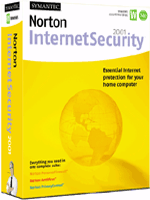


When I heard Symantec had come out with a new version of NIS, I was definitely surprised. I had V2.5 on my computers and I know they hadn't even been used more than four or five months. Since the upgrade to 3.0 was $49.95, I was hesitant, but curious, so I went to the Symantec web site to check out what was really new about NIS V3.0. And there's plenty, especially if you have an "always-on" connection to the Internet, such as DSL or cable.
So I got NIS 3.0 and installed it the very same day.
Symantec products are always easy to install and user-friendly, so I went through the step-by-step installation, noting the new features as I went along.
They include:
- Intrusion Protection with AutoBlock: This nifty feature detects when your computer is
being scanned by a hacker, then alerts you while it automatically blocks all traffic from the
attacker for a specified time (or forever, if you want)
- Internet Zone Control: If you have a home or SOHO network, this allows you to easily
and very quickly configure NIS so that it works perfectly with your network.
- Internet Access Control: If an application on your computer attempts to access the
Internet and you haven't told it to, you'll be alerted. You also get a "threat level assessment" to decided whether to permit or deny access to the Internet. You can then make that decision
permanent or make sure IAC checks every time that application tries to access the Internet.
- Norton AntiVirus Script Blocking: Probably one of the most important and best new
features, this protects your computer from known and unknown JavaScript and VBScript-based
threats without the need for virus definitions. If you haven't had a chance to update your
definitions, this will make sure your computer stops viruses like the nasty "I Love You" or
Melissa and alerts you if one tries to invade your system.
During set-up, I was allowed to set my controls for each aspect of NIS 3.0, the most interesting of which was when it performed an application scan of my computer, then let me know which applications that could access the Internet. I was then instructed to select which, if any, I wanted to allow access, and of those, let them access automatically, block them, or ask me each time they try to access the Internet. I found some applications that I had no idea could possibly access the Internet and began to wonder if they had in the past and how often.
If you've got a DSL or cable modem, NIS refuses all Internet activity until you log back on again yourself, completely protecting your computer when you're not around. This is absolutely wonderful and a relief.
The firewall can be set to "Full Stealth" mode so that it won't respond to TCP port probes, basically informing a potential hacker that no computer exists.
The rest of the set-up was fairly simple (you can change the settings to suit your needs or leave them at the default settings):
Reporting - A feature called AlertTracker can keep track of everything your computer does online. Set it to high (what I call totally paranoid mode) and it will keep popping up every time a cookie is set, when unused ports are blocked, when port scans occur and more. I set mine to Medium (yes, I'm a bit paranoid), which means I'd be notified when applications accessed the Internet, if a Trojan Horse program is trying to gain access and more. Low provides minimal protection, but if you're not paranoid at all or don't have anything you're worried about on your computer, then this is for you.
Personal Firewall - I set it to Medium to block known malicious applications or else the High setting would alert me too often; I left the other settings at default, which was to allow Java Applets and ActiveX Controls, as well as enabling Access Control Alerts and when unused ports were accessed.
Internet Access Control is what was set up when NIS 3.0 scanned for applications that could access the Internet. You can change settings here, or add or delete applications.
Internet Zone Control is if you have computers networked together and allows you to either add them to the trusted or restricted list.
Intrusion Protection detects the more common hacker attacks on your computer, including port scan attempts. You can also AutoBlock computers in your network if you want.
Privacy Control - Alerts you if confidential information is trying to be sent online. You add what confidential info you don't want to be sent unless you give permission, such as your Social Security Number, a credit card number, birthdate, etc. You also set Cookie permissions here. I set mine to allow cookies only because I have Anonymous Cookie installed and that keeps the more annoying ones off my computer.
Get rid of those banner ads with Ad Blocking. This works most of the time and is wonderful.
Don't forget Norton AntiVirus, which is included! You can set it to scan your e-mail while it's being downloaded so that it's virus-free, which works much better this time around than in the last version (my Eudora Pro kept crashing before, now it works great with NAV).
If you have NIS 2.5 on your computer/network, then seriously consider the upgrade, yes, even though it's $49.95. If you don't have NIS on your computer at all, then you should get NIS 2001 3.0 - it's only $69.95 and provides complete protection for your computer/network. Another plus is that you get one year of free virus definition and firewall updates.
If you're still undecided, then use Symantec's Security Check to assess the vulnerability of your system on the their site
Norton Internet Security 2001 V3.0 - Includes Norton AntiVirus, Norton Personal Firewall and
Norton Privacy Control.
Purchase it online or at your local retailer
J.A. Hitchcock is a regular contributor to Compute Me. Visit her web site at jahitchcock.com.